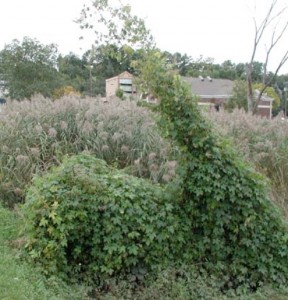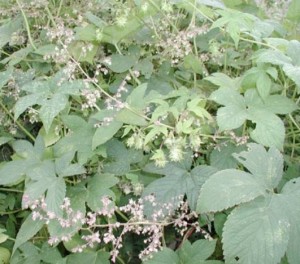Japanese Hop
Humulus japonicus
Japanese Hop
Native origin: East Asia
This member of the Hemp plant family was brought to the U.S. from East Asia in the 1880s, and still is used to flavor Asiatic medicinal tonics and as an ornamental vine.
Description: This usually annual vine climbs by twining and does not have tendrils. The rough-textured, tooth-edged paired leaves are two to four inches long and have five to seven (sometimes nine) lobes. The stout stems and leaves carry numerous sharp, downward-pointing prickles that can irritate the skin and may cause dermatitis and blistering. The small greenish-yellow male flowers occur on separate plants from the larger light green, drooping cone-like structure that holds the female flowers. Round seeds are about one-eighth inch in diameter and turn light brown with dark specks as they mature.
Habitat: Will grow in a variety of soil and light conditions but prefers moist soils and sunlight. Most commonly found near stream banks and in floodplains, Japanese Hop readily invades open woodlands and forest edges. It is hardy to USDA zone 5 and plants may survive mild winters. New infestations occur as seeds are readily spread by animals, machinery and floodwaters.
Ecological Threat: With a 10-foot annual growth rate Japanese Hop vines can quickly overgrow low vegetation, shrubs and small trees. Dense mats several feet in depth block light to all other plants and can leave bare ground which then serves as an even better seedling growth area in following years. Several thousand plants per acre can occur in heavily infested areas.
Manual Control: The shallowly rooted plants can be pulled from moist soil, taking care to get the entire root mass. This method is effective in spring before the plants set seed. It is important to avoid skin contact with the plant as blistering and dermatitis may result from the prickles on the stems and leaves.
Mechanical Control: Repeat and frequent mowing, where possible, may control this plant, particularly in areas where winter kills the vines. Mowing must be repeated to prevent seed set.
Chemical: Foliar spraying with general use systemic herbicides, such as glyphosate (Roundup) is effective. Repeat treatments may be needed to penetrate the dense vine coverage and/or to control new seedlings. Manufacturers’ directions should be followed, particularly when control measures are to be done near water.
Comments are currently closed.


